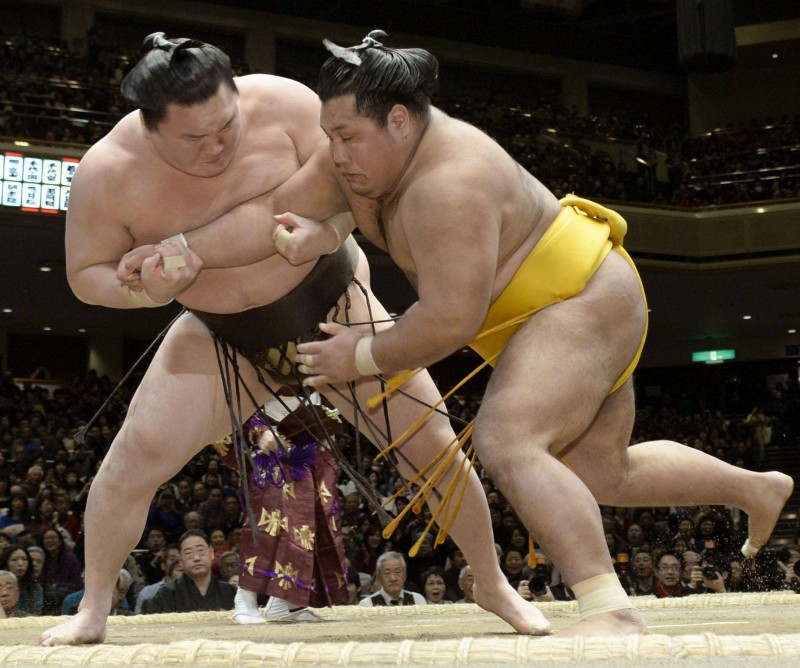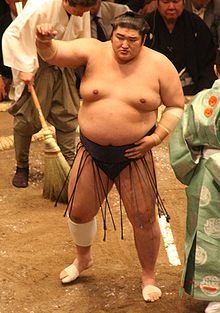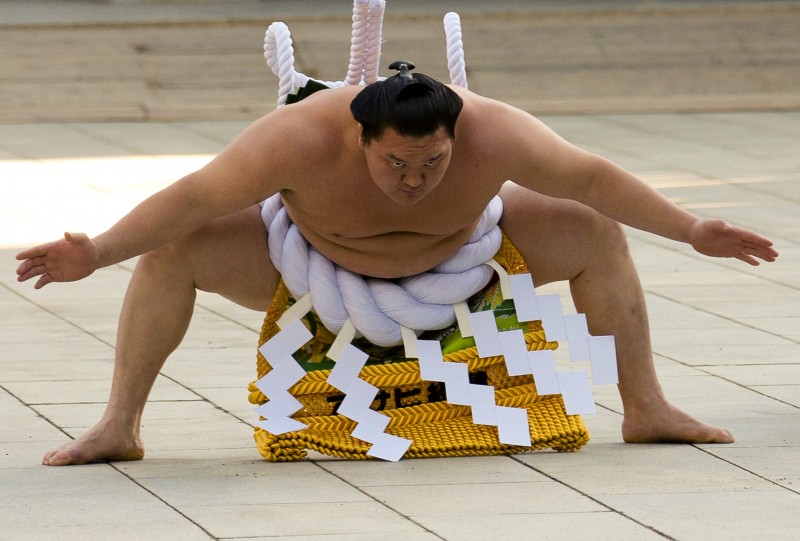
New Year tournament, 2014 (courtesy Japan Times)
I happened on an illuminating site this week while researching a haiku by Buson about sumo which intrigued me. The sport of course had religious beginnings, as detailed below, being put on as an entertainment for the kami and by extension the aristocracy. During samurai times, when physical strength was highly evaluated, samurai families employed wrestlers and Nobunaga is said to have been a fan. Until the late seventeenth century performance was restricted to the elite, however, and even banned for the wider public because of its disruptive effect on law and order. Only during the Genroku Period were restrictions lifted, after which it spread in popularity. The first Osaka tournament was held in 1702, marking the beginning of modern sumo as we know it.
*****************
From the Sumo Talk website…
Shinto is the native religion of Japan and is more a set of rituals and ceremonies than a system of beliefs or a definite code of ethics. The word itself means “way of the gods.” Sumo was originally performed to entertain the gods (kami) during festivals (matsuri). Sumo as part of Shinto ritual dates as far back as the Tumulus Period (250-552), but it wasn’t until the 17th century that it began adopting the intense purification rituals that we see in sumo today.
Most of the Shinto that we see in sumo occurs symbolically. To begin with, the sand that covers the clay of the dohyo is itself a symbol of purity in the Shinto religion. And the canopy above the ring (yakata) is made in the style of the roof of a Shinto shrine. The four tassels on each corner of the canopy represent the four seasons, the white one as autumn, black as winter, green as spring and red as summer. The purple bunting around the roof symbolizes the drifting of the clouds and the rotation of the seasons. The referee (gyoji) resembles a Shinto priest in his traditional robe. And kelp, cuttlefish, and chestnuts are placed in the ring along with prayers for safety.

A woodblock print of sumo in Edo times
Each day of the tournament (basho), a ring entering ceremony is held, wherein each wrestler’s body and spirit undergoes purification. Yokozuna are dressed in mawashi with five white zigzag folded strips of paper on the front, the same as those found at the entrance of Shinto shrines. On the front of all mawashi are sagari, which are fringes of twisted string tucked into the belt, and they represent the sacred ropes in front of shrines. Numbers of strings are odd, between seventeen and twenty-one, which are lucky numbers in the Shinto tradition. And of course, the salt that is tossed before each bout is an agent for purification and one of sumo’s most visible rituals.
As a religion of customs and not laws, Shinto developed as a religion to please the gods in order to ensure a good harvest and divine protection, but soon made headway into the sport of sumo as a way to entertain those same gods, purify the sport itself and protect the wrestlers from harm.

Ozeki Kotomitsuki tosses salt into the ring as a form of purification and protection against injury ( Wikicommons)
The first ceremony of the day is the dohyo-iri, or ring ceremony performed by Juryo and Makuuchi rikishi before their bouts begin. The rikishi are grouped into two groups—East and West—and each group takes a turn entering the ring. The lowest-ranked rikishi enters first and walks a complete circle around the ring followed by the other rikishi in ascending order according the rank.
Before the individual rikishi enter the ring, they are introduced to the spectators. Once the last rikishi in the group has been introduced, the rikishi, who are facing the spectators, turn inward and face each other around the ring. After clapping their hands once, they raise their right hand, lift their kesho-mawashi (decorative aprons created for the ring ceremony), and finally raise both hands in unison. This tradition goes back to the samurai days and represents the rikishi showing each other that none is armed.
During the Makuuchi ring ceremony, the Yokozuna are notably absent from the group as they must perform their own individual ring ceremonies. When a Yokozuna performs his ring ceremony, he will wear a white tsuna, or zuna (braided rope with five zig-zag shide strips hanging from the front), around his waist to signify his rank.
Once the actual bouts begin, the two rikishi spend several minutes before their match lifting their legs high in the air and stomping them down, a practice said to scare away any demons. They also throw several handfuls of salt into the ring, which is said to purify the ring. Many rikishi will also sprinkle salt around their bodies as a means of protecting themselves from injury. After the last bout of the day, the bow twirling ceremony is performed by a makushita-ranked rikishi from the same stable as a Yokozuna. True fans of the sport will not leave their seats until this ritual is performed.

Mongolian-born grand sumo champion Yokozuna Hakuho performs the New Year’s ring-entering rite Wednesday at the 2015 annual celebration for the New Year at Meiji Shrine in Tokyo. | REUTERS
